THE BLOCK UNIVERSE
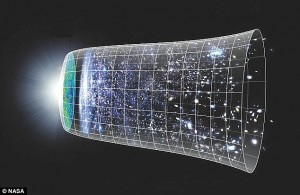
The “block universe” is a result of special relativity that can come as a surprise if you haven’t encountered it before, mainly because we can remember the past but not the future. So it seems to us as though the future is not already written. I shall discuss the source of this illusion in another page; here I want to explain the science behind the block universe.
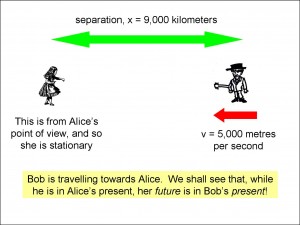
I am going to take the example of Alice and Bob who are separated by a distance of 9,000 kilometers (5,600 miles). Bob is travelling towards Alice at 5,000 metres per second (about 11,000 miles per hour). We can think of Alice and Bob in two different satellites in different orbits around the Earth. It takes light, or a radio signal, 0.03 seconds to travel between them. What I am going to show you is that, from Bob’s point of view, he is concurrent with Alice in her future, not in her present – albeit by a tiny amount, just 500 nanoseconds (0.0000005 seconds). I shall abbreviate “nanoseconds” as “ns” from now on.
Because it takes a radio signal much longer than 500 ns to travel between Alice and Bob (0.03 seconds, or 30,000,000 ns), there is no way that Bob can tell Alice what her future holds. Nevertheless, if they swap radio signals and compare them later, they will find that, indeed, Alice’s future, 500 ns ahead, was in Bob’s present when he was in her present. This means that all events, from Alice’s present right up to 499 ns in her future, are already in Bob’s past. Putting it another way, since Bob cannot alter his past, these events, which are still up to 499 ns in Alice’s future, cannot be altered. Alice’s future is already written!
I found to my surprise that the concept of the block universe remains controversial to this day with some physicists (see my Blog on this website), and so I wrote a paper on arXiv showing how it may be demonstrated experimentally. This page of the website is similar, but not identical, to that paper.
Incidentally, we are going to see things from Alice’s point of view. We can make a symmetrical argument from Bob’s point of view, showing that Bob’s future is in Alice’s present! Such is the nature of relativity!
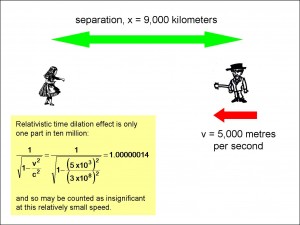
Although fixing your future only 500 ns ahead may seem small potatoes, the same principle can be used by any observers in the universe at any time, and so the whole of the future (and the past) can be shown to be “already written”.
In the following pictures, the only principle of relativity that we use is that the speed of light (or a radio signal) is the same for everyone, regardless of how fast they are traveling relative to anyone else. You will see that these pictures are not complicated by the celebrated time dilation of special relativity where time moves more slowly for people who are speeding past you. That is because I have chosen only a relatively small speed for Bob relative to Alice. In Figure 2, you will see the actual calculation of this time dilation effect – it is only one part in ten million at this speed.
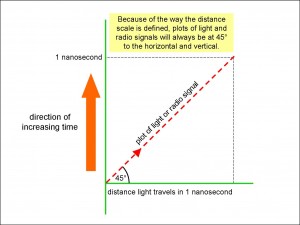
I am going to plot the paths of Alice and Bob with time in the vertical axis and the distance between them in the horizontal axis. You will see in Figure 3 that I have drawn the units of space to be, not in kilometres or metres, but in distance that light moves in one nanosecond. This makes the scales equal in size in both directions. If you plot the path of a light signal, it will be at an angle of 45° to the horizontal and vertical axes. (Such space-time diagrams are called Minkowski diagrams.)
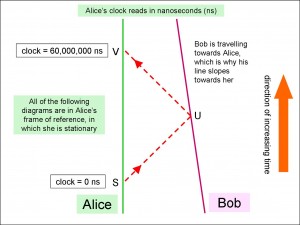
In Figure 4, you see Alice’s position represented by the green vertical line. It doesn’t move left or right because we are seeing things from her point of view – she doesn’t move. She only gets older, and so the green line shows her progress in time. The plot for Bob, on the other hand, is slanted towards Alice as time increases upwards. That is because he is moving towards her. Note that these diagrams exaggerate Bob’s motion very much – at such a low speed relative to that of light, the Bob’s plot would look vertical like Alice’s.
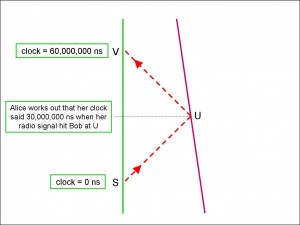
In this figure, we see that Alice sends off a signal towards Bob when her clock reads zero when she is at position S. The idea is that the signal carries the time on her clock at the moment it left Alice. It reaches Bob when he is at position U. The protocol is that he sends any signal he receives from Alice right back to her. So he sends the signal containing her clock reading of zero, along with his own clock reading at U. Since, as I said, it takes 30,000,000 ns for the radio signal to reach Bob, it will take another 30,000,000 ns for it to travel back to Alice. So, when she receives Bob’s returned signal when she is at position V, her clock reads 60,000,000 ns.
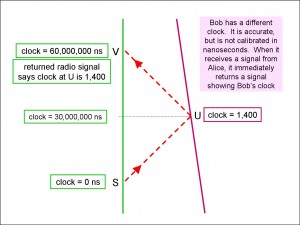
Since Alice has a signal from Bob that says it originated from Alice when her clock read zero, and since the time when she received that signal back at V is 60,000,000 ns, she can work out that it reached Bob at U when her clock read 30,000,000 ns (at the point M in the diagram (Figure 5).
Now, as I implied above, Bob also has a clock. Just to make it clear that the effects I am describing don’t rely on the two clocks agreeing with each other, I have made Bob’s clock tick much more slowly than Alice’s. As long as his clock doesn’t speed up or slow down, it won’t matter. Neither does it matter when he started his clock. Alice finds, when she reads the signal at V, that Bob’s clock read 1,400 time units when her signal from S reached him (Figure 6).
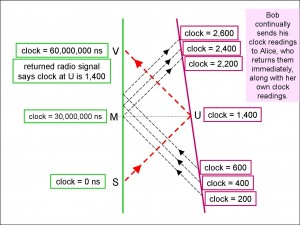
Bob continually sends signals to Alice that show the time on his clock (Figure 7). When she receives a signal from Bob, she immediately sends his signal back to him, along with the time on her own clock.
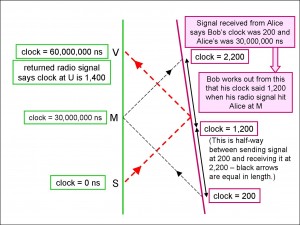
In the example in Figure 8, Bob receives a signal from Alice showing the time on her clock when it read 30,000,000 ns, along with the signal she received from Bob showing the time on his clock when it read 200. Since Bob receives this signal when his clock reads 2,200, he can deduce that Alice sent it when Bob’s clock read 1,200, which is half-way between 200 and 2,200. In other words, Bob knows that, when his clock read 1,200, he was contemporary with Alice when her clock read 30,000,000 ns (at the point M in the diagram).
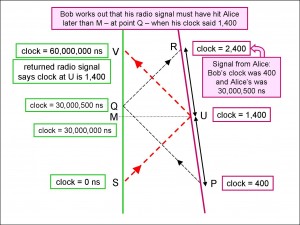
Since Alice received a signal at V which came from Bob’s clock when it read 1,400, she and Bob can ask (when they compare notes after the experiment), what did Alice’s clock read when Bob’s signal reached her at the moment his clock read 1,400? Bob looks through his records and finds one showing a signal received at R, when his clock read 2,400, along with the signal containing his original clock time of 400 at P. Clearly, his signal must have reached Alice half-way between these clock times, that is, when his clock read 1,400, which is the reading they are looking for (Figure 9).
So Bob sent a signal to Alice from P that reached her when his clock read 1,400. Moreover, we saw that this was also the reading on Bob’s clock when Alice’s signal reached him from S when her clock read 30,000,000 ns. But we can see in Figure 9 that the signal received at R by Bob carries not only the original clock time of 400 at P, but also the time on Alice’s clock when the signal reached her at Q. This time is 30,000,500 ns. So the time on Alice’s clock when Bob’s clock is at 1,400 is 500 ns after the time on her clock when her signal reached him at 1,400 by his clock! Bob was in Alice’s present when his clock read 1,400, but Alice’s future, 500 ns ahead, was in Bob’s present when his clock still read 1,400!
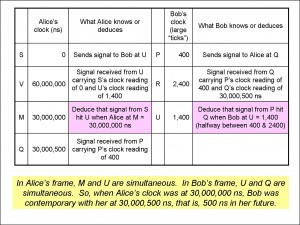
Figure 10 just collects together the information that Alice and Bob have when they get together after the experiment. Although all of these events now lie in their past, nevertheless, they can see that, when Alice’s clock read 30,000,000, all events up to 500 ns in her future were already in Bob’s past!
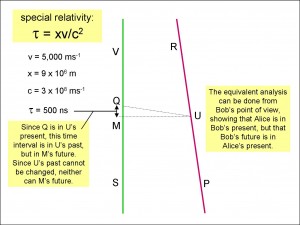
Figure 11 shows this graphically, along with the special-relativity formula for calculating this time interval, tau (Greek “t”), where tau= xv/c2.
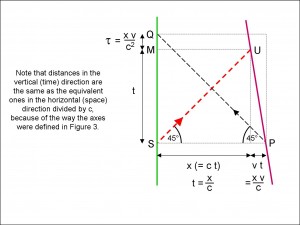
For those interested in mathematics, Figure 12 shows how the time interval may be derived using simple geometry. From the way we defined lengths in Figure 3, the size of a vertical line (in the time direction) is given by the equivalent horizontal line (in the space direction) divided by the speed of light, c.
As I said at the beginning, you can choose other observers at any time across the cosmos, sufficient to cover every event that ever happened or ever will happen. Interestingly, for all his somewhat equivocal attitude to science, and, indeed, occasional disparaging remarks about Einstein himself, T S Eliot captures a key aspect of the block universe remarkably well in the opening lines of his (admittedly religious and mystical) “Four Quartets”:
Time present and time past
Are both perhaps present in time future,
And time future contained in time past.
If all time is eternally present
All time is unredeemable.
Click here to go to [4] Causality and Special Relativity
